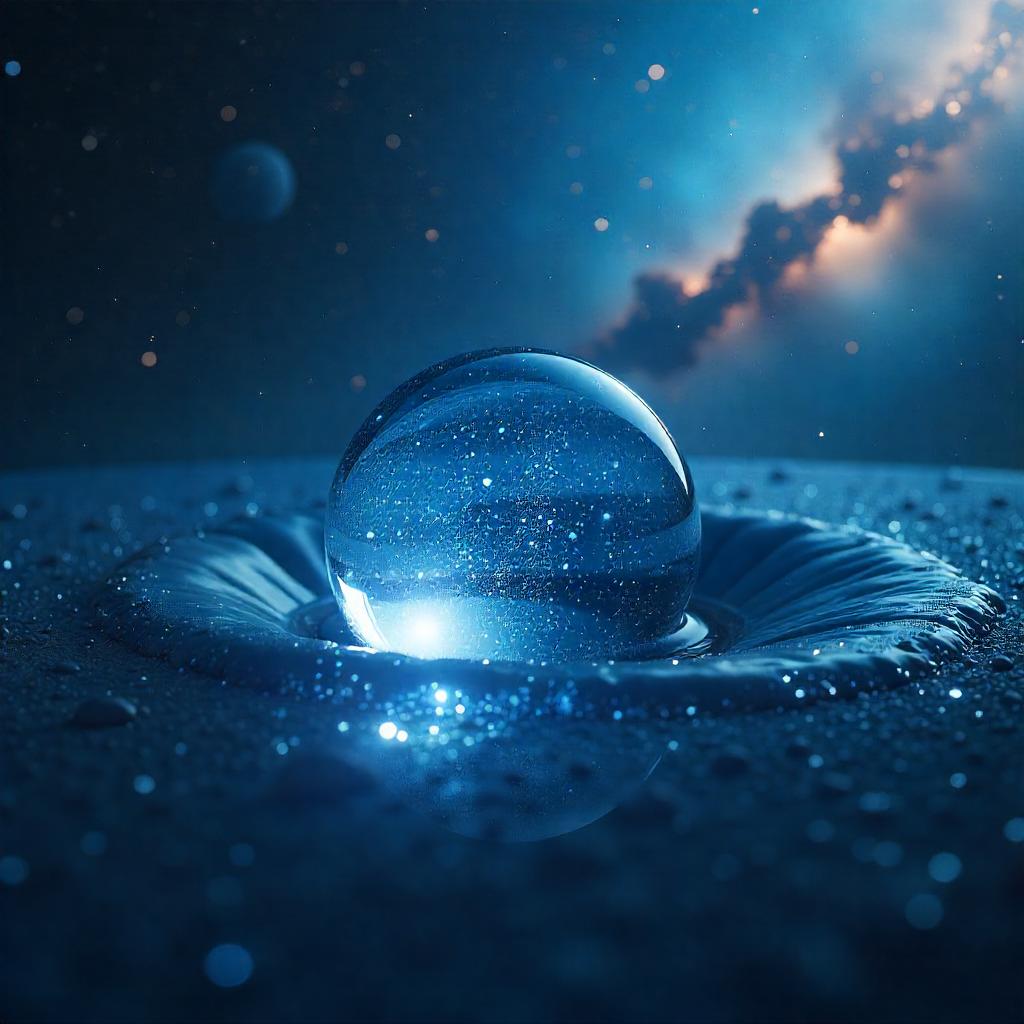Water in Space In recent years, NASA has made groundbreaking strides in uncovering the mysteries of space, one of the most exciting of which is the discovery of water in space. Water, an essential element for life as we know it, has been found in various forms across our solar system and beyond.
From icy moons to distant exoplanets, NASA’s findings have not only revolutionized our understanding of the cosmos but have also opened up new possibilities for future space exploration and the search for extraterrestrial life. In this blog post, we’ll dive deep into NASA’s discoveries, how they’ve found water in space, what it means for life beyond Earth, and the implications for future missions.

1. Water: A Key Element for Life
Water is fundamental to life on Earth, supporting ecosystems and biological processes across the planet. Because of its importance, scientists have long been interested in finding water elsewhere in the universe. The presence of liquid water is considered a critical factor in determining whether a celestial body could potentially support life, as we understand it.
NASA’s search for water in space is not just about uncovering a scientific curiosity—it is about understanding the potential for life beyond our planet.
Water exists in space in various forms—ice, vapor, and even liquid under specific conditions. It’s found in the clouds of gas and dust that make up galaxies, the icy bodies orbiting distant stars, and even in the form of vapor in the atmospheres of some planets.
NASA has employed a combination of space missions, telescopic observations, and robotic exploration to investigate these possibilities.
2. Early Discoveries: Water in Our Own Solar System
The Moon and Water Ice
One of the earliest and most significant discoveries of water in space came when NASA’s Lunar Reconnaissance Orbiter (LRO) detected traces of water ice on the Moon in 2009. This discovery was critical because it suggested that water might be more widespread in the solar system than previously thought.
The presence of water ice on the Moon, especially near its poles, opened up new possibilities for long-term human presence on the lunar surface. Water could be extracted and purified for drinking, and the hydrogen and oxygen could be used for fuel in future space missions.
This discovery was a stepping stone in NASA’s vision of returning humans to the Moon under the Artemis program, which seeks to establish a sustainable human presence on the Moon by the end of the decade.
Water in Space Mars: The Quest for Past and Present Water
Mars has long been a focal point in NASA’s search for water. For decades, scientists have suspected that Mars once had large bodies of water, possibly oceans. NASA’s rovers, such as Spirit, Opportunity, Curiosity, and Perseverance, have provided crucial data on Mars’ geological history, revealing signs of ancient river valleys, lake beds, and minerals that only form in the presence of liquid water.
One of the most exciting discoveries came from the Curiosity rover in 2013, which found evidence of an ancient Martian lake that could have supported microbial life billions of years ago.
Furthermore, scientists have identified recurring slope lineae (RSL) on Mars—dark streaks that appear to flow down slopes during warmer months. These features are thought to be caused by briny water, though the exact composition and the source of the water remain a subject of ongoing investigation.
In 2018, NASA’s InSight lander detected evidence of underground water reservoirs on Mars. Using seismic data, scientists believe that liquid water may exist beneath
the planet’s surface in the form of salty aquifers. This discovery is essential for understanding the planet’s potential to support microbial life in the present and future human exploration of Mars.
Water in Space Jupiter’s Moons: Europa and Ganymede
Some of the most intriguing discoveries of water in space come from the moons of Jupiter, particularly Europa and Ganymede. Europa, in particular, has been the subject of intense interest because of its thick ice shell and the possibility of a subsurface ocean beneath it.
NASA’s Hubble Space Telescope has detected plumes of water vapor erupting from Europa’s surface, suggesting that liquid water exists beneath the icy crust.
In 2021, NASA’s Europa Clipper mission was approved and is set to launch in the 2020s. This mission aims to explore Europa’s ocean and ice shell to better understand its potential for supporting life. Ganymede, the largest moon in the solar system, also shows evidence of a subsurface ocean, and NASA is planning a mission to this moon with the upcoming JUpiter ICy.
3. Water Beyond Our Solar System: Exoplanets and the Search for Life

While NASA has made great strides in discovering water within our own solar system, the search for water on exoplanets—planets outside our solar system—has also been a major focus. In recent years, NASA’s Kepler Space Telescope and Transiting Exoplanet Survey Satellite (TESS) have identified thousands of exoplanets, many of which are located in the so-called “habitable zone”—the region around a star where conditions might be right for liquid water to exist on the surface.
Water in Space The Trappist-1 System
One of the most exciting discoveries came in 2017 when NASA announced the discovery of seven Earth-sized planets in the Trappist-1 system, three of which are located in the habitable zone. While the presence of liquid water on these planets remains unconfirmed,
the discovery raised hopes that we could one day find signs of life beyond our solar system. Researchers are currently analyzing the atmospheres of these planets for potential biosignatures, including the presence of water vapor.
Water in Space Water in Exoplanet Atmospheres
NASA’s James Webb Space Telescope (JWST), launched in December 2021, is expected to significantly advance our ability to detect water in the atmospheres of exoplanets. JWST’s advanced capabilities in infrared spectroscopy will allow scientists to detect the chemical composition of exoplanet atmospheres, including the presence of water vapor, carbon dioxide, and methane.
This mission holds the promise of expanding our understanding of potentially habitable exoplanets and providing insights into the likelihood of finding life elsewhere in the universe.
4. How NASA Detects Water in Space
NASA uses a variety of tools and techniques to detect water in space, each tailored to the different environments where water might be found. These methods include:
Telescopic Observations
Telescopes like the Hubble Space Telescope and the James Webb Space Telescope are key tools in NASA’s search for water in space. These telescopes can detect the light emitted or absorbed by water molecules in distant stars, planets, and moons. Infrared light, in particular, is useful for detecting water vapor in the atmospheres of exoplanets.
Space Probes and Rovers
NASA has sent numerous robotic probes and rovers to planets and moons in our solar system to directly investigate the presence of water. Rovers like Curiosity and Perseverance on Mars, and orbiters like the Lunar Reconnaissance Orbiter, use sophisticated instruments to analyze soil, ice, and atmospheric samples to detect the presence of water in different forms.
Spectroscopy
Spectroscopy is a technique used to analyze light across a range of wavelengths. By studying how light interacts with the materials on a celestial body’s surface or in its atmosphere, scientists can determine the chemical composition of these materials. Spectroscopic data has been critical in identifying water vapor, ice, and other compounds on distant planets and moons.
5. The Implications of Water in Space
The discovery of water in space has profound implications for science and space exploration.
Water in Space The Search for Extraterrestrial Life

One of the most significant implications of finding water in space is the potential for extraterrestrial life. Water is a key ingredient for life as we know it, and its presence in environments like Mars, Europa, and exoplanets increases the likelihood that life—either microbial or more advanced—could exist elsewhere in the universe. Scientists are studying these discoveries closely to determine if conditions could support life, both in the past and present.
Future Space Exploration
Water is also essential for the future of human space exploration. As NASA plans for missions to the Moon, Mars, and beyond, water will play a crucial role in supporting astronauts. It can be used for drinking, growing food, and even producing oxygen and hydrogen for fuel. Discovering water on the Moon, Mars, and other celestial bodies will make it easier for humans to live and work in space for extended periods.
Water in Space The Search for Habitable Exoplanets
The discovery of water on exoplanets is vital to understanding the potential for life beyond our solar system. As astronomers continue to find more Earth-like exoplanets in the habitable zone, the presence of water is a key factor in assessing whether these planets could support life. The next generation of telescopes, including the James Webb Space Telescope, will provide further insight into the atmospheres of these distant worlds.
6. Conclusion
NASA’s discovery of water in space is a monumental achievement in our quest to understand the universe. From finding water ice on the Moon to detecting plumes of water vapor on Europa, NASA has opened up new avenues for exploration and the search for extraterrestrial life.
As our technology and exploration capabilities continue to advance, we are likely to make even more exciting discoveries in the years to come. Water in space doesn’t just suggest that life could exist elsewhere—it also means that the dream of humanity living and thriving on other planets may one day become a reality.
Can We Live on Mars After the Discovery of Water in Space?
The discovery of water in space, particularly on Mars, has captured the imagination of scientists, space enthusiasts, and futurists alike. For years, scientists have been searching for signs of liquid water on Mars, and now, with recent advancements in space exploration, the question of whether humans can one day live on the Red Planet is closer to being answered.
While the presence of water on Mars is a crucial step toward making human habitation possible, it’s only one piece of the puzzle. To answer the question of whether we can live on Mars, we must consider several other factors, including the challenges of the Martian environment, how we would utilize water on Mars, and the technology required to sustain human life.
Let’s explore the discovery of water on Mars and what it means for potential human colonization.
1. The Importance of Water on Mars
Water is essential for life as we know it, making it a fundamental component for sustaining human life on Mars. The presence of water on the planet is crucial for several reasons:

Water for Drinking and Food Production
The first and most obvious use of water is for drinking. Astronauts on Mars would need water for hydration, as well as for cooking and food preparation. Additionally, water is essential for growing crops, which could provide a sustainable source of food for long-term missions or permanent settlements. NASA and other space agencies have been exploring the possibility of growing food in space using hydroponics, where plants are grown in nutrient-rich water instead of soil.
Water in Space Water for Oxygen Production
Water is also critical for producing oxygen, which is needed for human respiration. The oxygen produced would be used for breathing, while the hydrogen could be used as a fuel source. This process could provide an essential life support system for a Mars colony.
Water for Fuel
Hydrogen extracted from water could also be used as a fuel for rockets or other machinery. The production of fuel on Mars using locally available resources (a process known as in-situ resource utilization or ISRU) is a key part of NASA’s long-term plans for human missions to the planet. Using water as a fuel source would help make human exploration of Mars more sustainable, reducing the need to transport fuel from Earth.
2. How Water Was Found on Mars
Over the years, scientists have gathered substantial evidence indicating that water exists on Mars in various forms. This discovery has been made through a combination of rover missions, orbiting spacecraft, and advanced telescopic techniques.
Water in Space Water Ice
One of the first signs of water on Mars came in the form of ice. NASA’s Mars Odyssey orbiter, launched in 2001, detected large amounts of water ice beneath the Martian surface, particularly near the planet’s poles. The Mars Phoenix Lander, which touched down on the planet in 2008, confirmed the presence of water ice in the polar regions. The detection of water ice is crucial because, although it’s not in liquid form, it could potentially be mined and used for drinking water or converted into oxygen.
Water in Space Subsurface Water
In addition to water ice, NASA’s Curiosity rover and other missions have provided evidence of ancient water flows on the Martian surface, including river valleys and lakebeds. This suggests that Mars once had liquid water on its surface, which could have supported microbial life in the past.
More recently, scientists have found evidence of salty, liquid water in the form of recurring slope lineae (RSL)—dark streaks on the surface that appear to flow down Martian slopes during warmer months. These features could potentially indicate the presence of liquid water beneath the surface, though much more research is needed to confirm this.

Permafrost
Mars has also been found to have permafrost—layers of frozen water beneath the surface. In some areas of Mars, especially at higher latitudes, the permafrost extends to great depths, and this frozen water could be a vital resource for future explorers. The ability to extract and utilize this water is a critical step in making Mars a viable location for human colonization.
3. Water in Space Challenges of Living on Mars
While the discovery of water on Mars is a significant breakthrough, there are many challenges that must be overcome before humans can establish a permanent presence on the planet. Mars has a harsh and unforgiving environment, and any attempt at colonization will require significant technological advancements.
Water in Space Thin Atmosphere and Lack of Oxygen
One of the most significant challenges for human survival on Mars is the planet’s thin atmosphere, which is made up mostly of carbon dioxide (CO2) with very little oxygen. The atmospheric pressure on Mars is less than 1% of Earth’s, meaning that humans would need to live in pressurized habitats to prevent suffocation. This also means that we would need to bring oxygen or find ways to produce it locally, such as through electrolysis of water.
Radiation Exposure
Mars does not have a protective magnetic field like Earth, which means that its surface is exposed to higher levels of cosmic radiation and solar radiation. Prolonged exposure to this radiation could have harmful effects on human health, including an increased risk of cancer and other health issues. Any Mars colony would need to develop effective shielding for astronauts, whether that involves building habitats underground or using special materials to protect them from radiation.
Extreme Temperatures
Mars has a cold climate, with average surface temperatures around minus 80 degrees Fahrenheit (minus 60 degrees Celsius). Temperatures can drop even lower, particularly at night or near the poles. In order to survive, humans would need to live in insulated habitats that maintain a warm temperature. The presence of water in the form of ice could be helpful in maintaining a more stable temperature, but the extreme cold would still present a challenge for human survival.
Water in Space Low Gravity
Mars has only about 38% of Earth’s gravity, which could have unknown effects on the human body over extended periods. Prolonged exposure to low gravity could cause muscle atrophy, bone density loss, and other health issues. Research into how the human body adapts to Martian gravity is an ongoing area of study, and future astronauts may need to engage in regular exercise and physical therapy to mitigate these effects.
4. The Role of Water in Overcoming These Challenges

Water could play a significant role in overcoming some of these challenges. For example:
Water for Radiation Shielding
One potential solution to Mars’ radiation problem is using water as a protective barrier. Water is an excellent shield against radiation, and scientists have proposed the idea of using water as a form of radiation protection. Water could be stored in tanks or incorporated into the walls of habitats to protect astronauts from harmful cosmic rays.
Water for Energy Production
Water could also be used to produce energy through the process of electrolysis, where water is split into hydrogen and oxygen. The hydrogen could be used as a fuel source for power generation, while the oxygen would be vital for human respiration. This would allow a Mars colony to be more self-sufficient and reduce reliance on supplies brought from Earth.
Water for Creating Livable Environments
Water could help maintain a stable environment within habitats. For example, water-based heating systems could be used to regulate the temperature inside Martian habitats. Additionally, water could be used in hydroponics systems to grow food, creating a closed-loop system that would reduce the need for Earth-based supplies.
5. Conclusion: Are We Ready to Live on Mars?
The discovery of water on Mars is a critical step in making human colonization of the planet a reality. Water will provide essential resources such as drinking water, oxygen, fuel, and a means to support agriculture. However, there are still many challenges to overcome before humans can live on Mars for extended periods. The Martian environment is harsh, with extreme temperatures, low gravity, a thin atmosphere, and high radiation levels.
To live on Mars, we will need to develop advanced technologies to extract and utilize water, protect against radiation, create sustainable habitats, and adapt to the challenges of living on a planet that is very different from Earth. While we are not yet ready to establish permanent colonies on Mars, the discovery of water is a promising sign that human habitation could be possible in the future.
NASA’s Artemis program, along with missions like SpaceX’s Starship, aims to lay the groundwork for human exploration of the Moon and Mars. As technology advances and new discoveries are made, humanity may one day call Mars home, creating a new chapter in our exploration of the cosmos. For now, the search for water on Mars continues to be one of the most exciting developments in space exploration.

Kuşadası partiler escort Kaliteli hizmet, temiz ortam ve profesyonel ekip! http://erugu.com/?p=6674
Kuşadası rus konuşan escort Hamile masajı çok nazik ve rahatlatıcıydı. https://www.salehabad.com/?p=57972
Küçüksu su kaçak tespiti Alibeyköy su kaçağı tespiti: Alibeyköy’de su kaçağına kesin çözüm için bizimle iletişime geçin. https://thesovereignstate.org/author/kacak/
Медицинский перевод: Ключ к точности и заботе о пациентах Мир медицины – медицинский перевод это область, где точность и ясность информации имеют решающее значение. Пациенты, врачи и медицинский персонал должны понимать документацию, результаты анализов и медицинские рекомендации на Сотрудничество Особенности восприятия иностранного языка и индивидуальные способности каждого учащегося регулируют то, насколько можно выучить словацкий язык именно вам по крайней мере на разговорном уровне. К тому же результат зависит от того, какая модель уроков вам по душе: это могут быть языковые курсы или индивидуальные уроки словацкого языка. Важно выбрать стратегию, которая подходит вам лучше всего.
https://files.fm/spiritesin1988/info
Завдяки моєму педагогічному досвіду та постійному професійному вдосконаленню, я ефективно використовую інтерактивні методи навчання для створення стимулюючого середовища, сприяючи активному і плідному вивченню матеріалу. Моя мета – виховати у дітей не лише математичну компетентність, але й розвивати…Докладніше » Ми працюємо за авторськими програмами, які написані з урахуванням нових потреб, знань маленької людини в сучасному світі
Ola, new friend! I’m hyped to hear your thoughts and ideas.
This site transported me to the top of South America, where I felt the thrill of standing at Machu Picchu as I navigated through its stunning layout. Each section is as awe-inspiring as the ancient ruins! I appreciate the opportunity to share my thoughts on this exceptional site!
Your website resembles a colorful candy bar and I’d love to have an expert confectioner like you explore my page Copper scrap environmental compliance
Bye-bye, and may your days be as radiant as the stars
Ищете, где [url=https://https://telegra.ph/Tajnye-tropy-darkneta-kak-ya-kupil-yad-dlya-cheloveka-02-13/]купить яд кураре[/url]?
Желаете знать [url=https://https://telegra.ph/Tajnye-tropy-darkneta-kak-ya-kupil-yad-dlya-cheloveka-02-13/]где купить яд с доставкой[/url]?
[url=https://maps.google.com.vc/url?q=https://lineage4free.ru]
слот hd[/url]
Want to [url=https://my-poison.shop/]buy poison for humans[/url]? We offer certified products with a guarantee of anonymity and results!
[url=https://my-gun.biz]
где купить оружие даркнет[/url]
Unlock Bitcoin Cash. $8252 Ready Now – https://t.me/+HkY2o13tXmtjY2My?Immups29rag
I think we could get along! Let’s talk?
Message me there! —> https://rb.gy/44z0k7?asself
Hi, my friend! Your smile and presence always bring joy to my heart.
Visiting this site transports me to the awe-inspiring La Feria de Abril in Seville, where flamenco dancers and colorful decorations create a fantastic atmosphere. The vibrant aesthetics make me want to celebrate life and indulge in joyous experiences. I’m eager to engage with you through my site Aluminium scrap repurposing trends
Keep the faith, and may your life be a symphony of harmony
Yo, my trusted companion! How have you been, my friend?
This site evokes the enchanting vibe of a moonlit night in Paris, with its romantic design and captivating details. The creators possess the artistry of poets, crafting an experience that feels dreamy and sophisticated. As I explore, I can almost hear the soft notes of a violin playing in the background, enhancing the atmosphere of beauty.
Your visit would be a wonderful gift to my website Places that pay for battery recycling
Until we meet again, stay strong and goodbye
“I sense we have plenty in common. Drop by https://rb.gy/44z0k7?asself ?”
Stroke of Genius is a micro-blade brow pencil that gives you blade-like precision when shaping and defining! You get 1 free item with every product purchased. It looks like you can still add more free item(s) to your cart. What would you like to do? Starting with the felt-tip tint, use light, fine strokes to fill in any gaps and add fullness, then flip it to use the pencil end to sketch the perfect shape. Consider the Maybelline Brow Ultra Slim Defining Eyebrow Pencil as the James Bond of brow saviors, because this formula is stealthy in the best way. The super-skinny tip allows you to create wispy, natural looking strokes that look completely natural, and the wax won’t bleed or flake. What We Don’t Love: If you press too hard, the pencil can be too pigmented. What We Love: For under $5 you can shape, tame, and define brows with this dual- ended pencil.
http://dayawane.ihep.ac.cn/twiki/bin/view/Public/DiannaNguyen
Sign up to our mailing list 8 recommendations Vintage Avon Nail Enamel Bundle Karnataka, India Clear Search Tell us if we missed any relevant information on the products? Phone:0301 0709999 These cookies enable us to provide better services based on how users use our website, and allow us to improve our features to deliver better user experience. Information collected is aggregated and anonymous. create a registry & get $100 in rewards; terms apply learn more become a member and get access to varied range of products and offers We only deliver within India at the moment. Your skin, made better! Our vitamin-packed primers, flawless high-coverage foundations and concealers, velvety powders, and hydrating natural perfectors deliver ultimate value and performance.
Good day!
Motions Academy – professional rehabilitation at your fingertips.
[url=https://motions.academy]Rehab programs tailored for post-injury and post-surgery care. Follow the link for details…[/url]
Thanks for attention.
Hello! I hope you’re having a great day. Good luck 🙂
Noordernieuws es tu guia definitiva para encontrar los mejores botes de casino. Aprende [url=https://www.flickr.com/people/202376727@N05/]barbarossa revenge demo[/url] como jugar estrategicamente y convertirte en el proximo jugador en llevarse un jackpot impresionante.
Other Downloads: x-Tower is attaching great importance to sustainability and less land consumption. Less turbines on slimmer towers in smaller farms achieve the same production and thus protect the natural scenery. 3.2m High Tower Credit: TowerThe Tower Good Food Duo 10-litre Oven and Air Fryer is split into two chambers. The first is a 5.5-litre ocean chamber while the second is a 4.5-litre basket. Both baskets can be used independently or simultaneously, and the two drawers have slightly different designs, including different handles and viewing windows. This is a High power versatile system, ideal for performances where high quality and high power is required, and space and weight restrictions mean you need an ultra compact system. X-ray technology is used to diagnose fractures, joint dislocations, or other common conditions. Our fully digital radiology equipment is quicker and more efficient in obtaining high-quality images with less radiation. Your results will be shared electronically with your referring medical provider and stored in your electronic medical record (EMR).
https://pumpyoursound.com/u/user/1478470
“My experience with Origin Pc has left me extremely satisfied with my purchase, speedy and truly HELPFUL customer support, amazing communication from their team throughout the whole process, quick… Complete Trademark Acknowledgment Line (TAL)Arc, Arria, Celeron, Cyclone, eASIC, Intel Ethernet, Intel,the Intel logo, Intel Agilex, Intel Atom, Intel Core, Intel Evo, Intel Inside, the Intel Inside logo, Intel Optane, Intel vPro, Iris, Killer, MAX, Movidius, Pentium, Intel Select Solutions, Intel Si Photonics, Stratix, the Stratix logo, Tofino, Ultrabook, Xeon are trademarks of Intel Corporation or its subsidiaries. if Game not working on your mobile please write comments below 2025-03-12 05:06:40 Seller Name: Growgreenherbs Modern Retails Pvt Ltd Bhoganhalli So why, then, has Siege of Centauri just shot up to join these innovators at the top of my “best tower defence games ever” list?